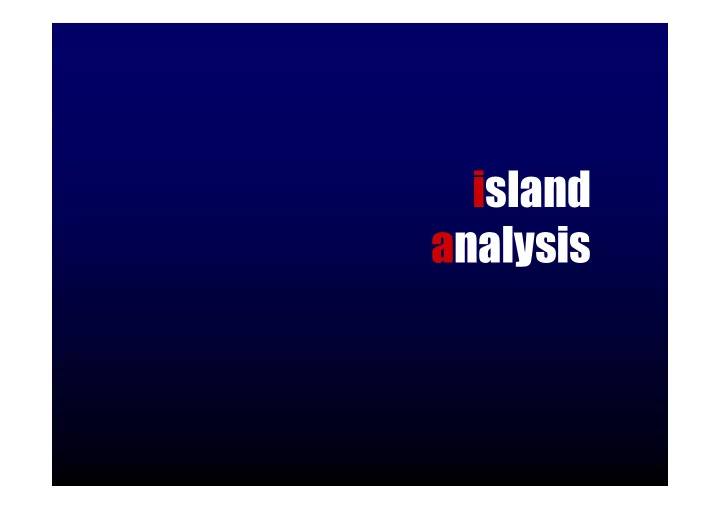

island analysis
Guernsey Community Foundation Poverty Measure - Benchmarking Study ia
Objectives 1. provide detailed assessment of how selection of islands identify poverty in their own jurisdictions, and what measurements are used 2. based on this assessment, identify best practice and what possible measures could be adopted in Guernsey 3. establish what economic and social data and information is currently available which could be used to generate these measures locally 4. define what extra research work would be necessary to obtain certain key poverty indicators for the future ia
Methodology • Identifying appropriate island jurisdictions and giving reasons as to why these islands were selected • Recording relevant poverty measures which were applied as well as the services that were in place in the jurisdictions to mitigate poverty levels. • Assessing what data and information was already available in Guernsey which could be used to generate similar indicators locally • Identifying areas where data and information was not currently available but which would be invaluable to have in the future assessment of poverty in Guernsey ia
Islands studied Bermuda Prince Edward Island Iceland Tasmania Cayman Islands Singapore Guernsey ia
Primary reasons for selection • Advanced economic and social infrastructures but at different points on economic life cycle • Strong communities • Very good data and information • Mature public sector services • Effective voluntary organisations ia
Key Findings ia
‘Traditional’ Poverty Measurement • Most governments’ (including UK) key measure takes 60% of median income as poverty line • Easy to measure (lazy) and does provide useful comparisons over time, but essentially arbitrary definition and has been much criticised • Increasingly recognised that poverty is relative to country/island that person lives in and that it is not just taking a percentage figure (e.g. 60%) of the country’s/island’s overall median household income ia
Poverty • Clear that poverty definition covers wide range of living standards and issues o household size and status o access to basic living essentials o education o health, etc. • Perception is that there is widening of gap between rich and poor and inequality amongst resident household groups. This further highlights inadequacy of 60% measurement. ia
Two approaches • top-down approach takes existing government data and information and then assesses poverty levels from that data and information. Independent experts called upon to provide opinions on household and individual needs • bottom-up approach is the ‘consensual’ or ‘perceived deprivation’ method. Harnesses public opinion to determine • minimum acceptable living standards for the society being examined and • which households fall below these standards because of a lack of resources rather than through a lifestyle choice ia
‘Top down’ Approach (Bermuda model) • Internationally recognised methodology • Based on basket of goods and services (information already available from Household Expenditure Survey) • Basket comprises two broad expenditure areas • Food items • Non-food items • Expert and independent advice sought to determine • local vulnerable groups and • basket components ia
Vulnerable groups identified (PEI model) • Single parent families ( 80% of single parent families are female led) • Single individuals aged 45 to 64 and 18 to 24 (22% of single adult households were below LICO) • Persons with disabilities (16% of islanders reported one or more disabilities particularly 45 and over) • Native Canadians (average incomes are consistently lower than non-native Canadians) • Recent immigrants with low skills (e.g. asylum seekers etc.) ia
Three year Social Action Plan (PEI model) • Help those in poverty to move out of poverty by strengthening their educational (social) and economic opportunities and their participation in the labour force (if appropriate) • Protect and enhance the standard of living and quality of life for those unable to participate in the labour force for whatever reason • Provide fair and equitable opportunities for Islanders to participate in and contribute to the cultural, economic and social environment of Prince Edward Island ia
KPIs (PEI model) Social well-being performance indicators set using measures such as: • Labour force participation • Unemployment rates (all workers and youth unemployment) • Highest level of education achieved • Population in core housing need • Social Assistance caseload • Income inequality measures • Kindergarten readiness • Self-reported health status • Self-reported mental health • Life expectancy • Reduction in crime and anti-social behaviour. ia
Guernsey - next steps 1 • Low Income Threshold methodology (similar to the Bermuda methodology) – be used (simple to apply) • Much evidence contained in latest HES Survey (2103) that can be drawn upon relating to Island’s households’ ‘food’ and ‘non-food’ basket. It also sets out the spending patterns of the different household income groups over a year. • Requirement to obtain information from panel of experts (not a committee) to determine: • household expenditure weightings, nutrition, health and education, and • vulnerable ‘at risk’ groups • Determine frequency of measurement (annual, biennual) ia
Guernsey - next steps 2 True cost of poverty in Guernsey should also be measured which would: • be invaluable in focussing cost to States in the provision of services (education, health, etc.) to those households deemed to be in poverty as compared with the provision of services supplied to an average Guernsey household. This would then provide incentive to consider as a wise investment the funding of preventative measures both to pull households out of poverty and also prevent households from drifting into poverty (Social Action Plan). The setting of key performance indicators need to be determined ia
Guernsey - next steps 3 Many island communities endeavouring to raise awareness of local poverty issues by holding awareness weeks and events. If the above recommendations are accepted, then there would be real focus on what should be achieved from such an initiative. ia
thank you ia
Recommend
More recommend